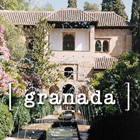
|
GRANADA: LAST OUTPOST OF A GOLDEN AGE Granada was once the seat of Moorish power in Spain, the last bastion to fall in the Spaniards' Reconquest of 1492. At the foot of the Sierra Nevada, where the Darro and Genil rivers meet, Granada boasts the beautiful and incomparable Alhambra palace, a World Heritage Site which served as the sprawling palacial city where the Caliphs of Al-Andalus last reigned. The city is also the home of flamenco music and culture, which is still performed by some of the best guitarristas, cantaores and bailaoras in the legendary Sacromonte caves.
Granada is a city of poets, of romance, and of music. The poet, Federico García Lorca was raised, lived and wrote here, and developed a special sense of the magic of place that is intertwined with the city of Granada, its long and winding history, and its ethnic rivalries. His work brought together not only the traditional forms in literature and the surrealist experimentation for which many now know him, but also the essence of a mixed cultural heritage struggling to find a voice that embraces all its faceted brilliance. It is also, sadly and fatefully, the city where Lorca was abducted and thought to be murdered by Franco's forces in a violent purge of politically liberal public figures and intellectuals, near the start of the Spanish Civil War in 1936. To this day, Lorca is one of the city's favorite sons, and his family home is a museum open to the public and a place of pilgrimage for students and aficionados of the great Spanish literature of the 20th century. One of the charms of Granada is that most of the major tourist attractions are within 20 min. walk of the Plaza Nueva, so it's easy to start from there, explore and regroup throughout the day. Granada is organized in such a way that a few hours' journey on foot can take you through history, and legend. Different legends hold that Granada was settled by a daughter of Noah, or by Granata, daughter of Hercules. The ancient indigenous settlement at Granada was called Ilbyr. The 5th Century BC Iberian settlement was later seized by Romans, who named it Illibris. Illibris may have been among the earliest Christian settlements on the Iberian Peninsula, hosting the first council of the Spanish Church around 300 AD. The records from this council make mention of a prominent Jewish community, known as Gránata, a community thought to have played a significant role in overthrowing the Visigoth rulers of later centuries.
When Moorish invaders took the city in 711 AD, they called it Gharnatah, possibly in reference to the same Jewish community that had helped define the city in the 3rd Century and afterward. The pomegranate fruit, which abounds in the nearby country, is called 'granada' in Castilian Spanish, but the coincidence of the Moorish name with the name of the fruit appears to be etymological serendipity. During the centuries in which the Spanish reconquest of Muslim territories was underway, Granada sought to secure its domain with reinforcements from North Africa, and eventually developed a policy of isolation from Castilian kings. The silk trade contributed to ongoing prosperity, and the kingdom of Granada would eventually stand as the last stronghold of Moorish power in Spain. It was the Nazarí dynasty that built the sprawling Alhambra palace, during the 14th Century. The palace overlooks the city of Granada, and contains not only elaborate residences for the ruling family, but also accomodation for thousands of servants and sentries. The Generalife Gardens are part of what once served as a summer resort palace within the vast complex. On the hill opposite the Alhambra is the Albaicín, the old Moorish casbah. There is an intimate weave of narrow streets, among whitewashed houses, leading to the Plaza de San Nicolás, and its renowned and lauded view of the Alhambra. The Albaicín also contains examples of the Moorish-granadino 'carmen' or enclosed garden courtyard.
In 1492, the Catholic Monarchs, Fernando de Aragón and Isabel de Castilla, retook Granada and forced the last Muslim rulers from the Iberian Peninsula. The chapel where Fernando and Isabel are buried is in the Granada Cathedral. Arab citizens of the city were allowed to continue living in accordance with their own practices, unitl in 1499, Cardinal Cisneros imposed mandatory conversion on all Muslims. Eventually, even their language, customs and clothing were prohibited, and penalty taxes were levied against them. Persecution led to mutiny in the Albaicín in 1500, and a flight into the hills of the Alpujarra range. Only in 1571, after losing the Battle of the Alpujarras, were the last holdouts forced from the city and its environs. The Sacromonte, famed for its historical gypsy community and flamenco-centered nightlife, is still a vibrant and unique attraction today. Many of the caves are now entertainment spots and nightclubs, though one can often find a real flamenco tablao, where authentic flamenco tradition is still maintained and cultivated. Sacromonte is located next to the Albaicín, where the Arab influences mixed with a concentrated Roma (Gypsy) population to form the intense musical strains and rhythm of flamenco, making this a sort of pilgrimate site for those who love the music and the dance. Carlos V added his own palace to the interior of the Alhambra, and in the 17th Century, Granada was a concentrated religious bastion of Baroque Spain. In the 19th Century, the city undergoes a number of expansions and renovations, including a new focus on the planning and maintenance of public parks, plazas and botanical gardens, in the French and English fashions of the times. The city continued to expand southward during the 20th Century, overflowing the Ronda beltway, intended to trace the edge of the city. Speculation and urban planning took over the sprawl, and large apartment blocks went up, defying not only the architectural traditions of the city, but also inviting a significant population of new inhabitants. Granada became a university town, now with one of the highest concentrations of students in Spain. There are now more than 60,000 students in Granada—Spain's third largest student population, equal to roughly 21% of the city's total population.
For more travel listings, original narratives and destinations, consult Sentido's sister site for travel, CavaTravel.com... |
|||||||||||||||||||||||||||||||||||||||||||||||||||||||
|
||||||||||||||||||||||||||||||||||||||||||||||||||||||||



















